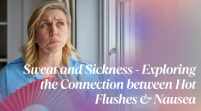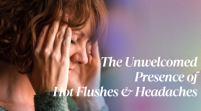Hot Flushes: Understanding, Managing, and Finding Relief
December 08, 2024

Hot flushes are a common and often disruptive symptom experienced by many people, especially during menopause or as a side effect of certain medical treatments like cancer therapies. These sudden waves of warmth can range from mild discomfort to intense sweating episodes that impact daily life and sleep quality.
This article provides a comprehensive guide to understanding hot flushes, their causes, and evidence-based ways to manage them. Using insights from experts, we’ll explore long-term relief strategies and highlight natural and medical treatments.
What Are Hot Flushes?
Hot flushes are sudden, intense sensations of heat that spread across the body, often accompanied by redness in the face and upper body, sweating, and sometimes chills afterward. They may last anywhere from a few seconds to several minutes, disrupting activities and sleep.
Symptoms of Hot Flushes:
- Sudden warmth in the face, neck, and chest.
- Sweating, particularly on the upper body.
- Flushed or reddened skin.
- Palpitations or a faster heartbeat during the episode.
- A sensation of chills after the heat subsides.
Duration of Hot Flushes:
Typically, hot flushes last between 4 to 5 minutes. However, the frequency and intensity can vary widely among individuals.
What Causes Hot Flushes?
Hot flushes are primarily linked to hormonal changes in the body, but they can also result from other medical conditions or treatments.
1. Hormonal Changes
- Menopause and Perimenopause: Hormonal fluctuations during menopause and perimenopause are the most common causes of hot flushes. As estrogen levels drop, the body’s temperature regulation system (hypothalamus) becomes more sensitive, triggering hot flushes.
- Low Testosterone Levels: Men undergoing treatments that lower testosterone levels, such as for prostate cancer, may also experience hot flushes.
2. Cancer Treatments
- Hormonal Therapies: Drugs used to treat breast, ovarian, and prostate cancer often lower estrogen or testosterone levels, triggering vasomotor symptoms.
- Chemotherapy and Pelvic Radiotherapy: These treatments can impact ovarian function, causing menopausal symptoms, including hot flushes.
3. Other Causes
- Infections or Illnesses: Conditions like fevers or infections can cause sensations of heat and sweating.
- Certain Cancers: Night sweats and hot flushes can sometimes signal underlying conditions, such as lymphoma.
The Impact of Hot Flushes on Daily Life
Hot flushes can significantly affect both physical comfort and mental well-being. They can:
- Disrupt sleep due to night sweats, leading to fatigue.
- Cause embarrassment and self-consciousness in social situations.
- Contribute to stress, anxiety, and even depression over time.
Managing Hot Flushes: Evidence-Based Strategies
Hot flushes can be challenging to eliminate entirely, but there are several effective ways to manage them. Combining multiple approaches often yields the best results.
1. Tracking and Avoiding Triggers
Identifying triggers for hot flushes can help minimize their frequency. Common triggers include:
- Spicy foods.
- Caffeine and alcohol.
- Stress or anxiety.
- Hot environments or heavy clothing.
Tip: Maintain a journal to record the timing, intensity, and potential triggers of hot flushes.
2. Lifestyle Modifications
- Layer Clothing: Wear layers that can be removed during a flush.
- Use Cooling Fabrics: Choose cotton or other natural materials for clothing and bedding.
- Stay Hydrated: Drink cold water or herbal teas to stay cool.
- Lower Room Temperatures: Use fans or air conditioning, especially at night.
3. Diet and Weight Management
- Maintain a Healthy Diet: A balanced diet rich in whole foods, fruits, vegetables, and lean proteins supports overall hormonal balance.
- Limit Alcohol and Caffeine: Both can exacerbate hot flushes.
- Lose Excess Weight: Research suggests that losing weight, if appropriate, can reduce the severity of hot flushes.
4. Complementary Therapies
- Acupuncture: Involves inserting fine needles into specific points on the body to reduce the frequency and intensity of hot flushes.
- Yoga and Controlled Breathing: Deep breathing techniques and yoga can reduce stress, a common trigger for hot flushes.
- Herbal Remedies: Supplements like black cohosh, red clover, or soy isoflavones are popular. Consult a healthcare provider before starting supplements, especially during cancer treatment.
5. Medical Treatments for Hot Flushes
- Hormone Replacement Therapy (HRT): Highly effective but may not be suitable for women with certain health conditions.
- Non-Hormonal Medications: Options like fezolinetant, antidepressants, or gabapentin can help manage symptoms.
Conclusion
Hot flushes are more than just a temporary inconvenience—they can significantly affect quality of life. Understanding their causes, exploring effective management strategies, and seeking support are critical steps toward relief.
From lifestyle adjustments and complementary therapies to the latest medical treatments like fezolinetant, there’s a solution for every individual. By staying informed and working closely with healthcare professionals, you can take control of your symptoms and live with greater comfort and confidence.
Resources:










































